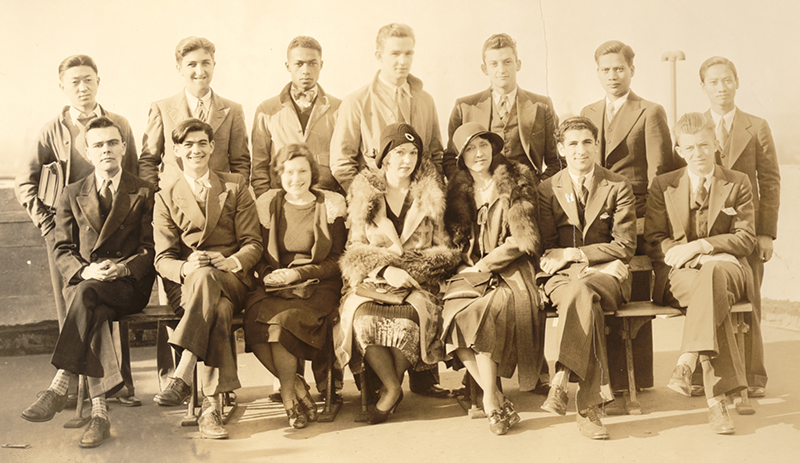
History of Southwestern
For over 100 years, Southwestern has continued to provide progressive legal education programs that prepare students with diverse backgrounds to earn positions of responsibility and trust within the legal profession and the community.
Southwestern Law School began in Fall 1911 when a small group of determined students first met with a tutor in the old Union Oil building in downtown Los Angeles. This collective, known as Southwestern College of Law, was organized as a nonprofit educational institution by John J. Schumacher. His dream was to provide legal education opportunities for qualified students who might not otherwise be given a chance to pursue such a degree. Strong academic and scholarly ambitions also accompanied the founding - Southwestern was the first law school in Southern California to use the Harvard case method of instruction and established a law review when most schools emphasized entering the profession over scholarship.
From the outset, Southwestern actively encouraged the enrollment of women and minorities. The law school's first graduate was Betty Trier Berry, who became the first woman in the United States to serve in a public defender's office. Numerous other Southwestern alumni were trailblazers in the profession, such as: Hon. Tom Bradley, the first African American Mayor of Los Angeles who served an unprecedented five terms; Hon. Ronald Lew, the first Chinese American district court judge in the continental United States; Hon. Arleigh Woods, the first female African-American appellate court justice; and Hon. Vaino Spencer, the first female African American judge in California; and Hon. Frances Muñoz, the first Latina judge in California.
As the second law school in the Los Angeles area, Southwestern experienced immediate growth, prompting larger and larger campuses. By 1915, the college had expanded to include several other disciplines (commerce, accounting, and finance), received a university charter, and moved to a larger location on Spring Street. More than 100 students were enrolled by 1920, and three years later, the school began construction on the South Hill Street campus, which served as the primary site for the next five decades.
During this early period, an active student body established several publications, fraternities and sororities, a debate squad (that captured the 1927 Southern California Public Speaking Conference championship), several athletic teams, and the Southwestern Alumni Association. Through the 1930s and World War II, the school's enrollment declined only to resurge as returning veterans returned to complete their education. While the law school once again developed into a strong and popular department, the last of the other educational departments were discontinued as similar programs became more accessible through the then tuition-free community colleges.
In the 1970s, Southwestern gained full accreditation from the American Bar Association, was awarded membership in the Association of American Law Schools, and established the country's first two-year J.D. program (SCALE®). During that era, the law school also moved west from downtown to larger, more modern facilities in the Wilshire Center district of Los Angeles. The following decade, the law school added a fourth J.D. program, PLEAS, one of the first part-time day options for students with child or eldercare responsibilities; established summer abroad programs in Argentina, Canada, England, and Mexico; and developed one of the most extensive externship programs in the country.
In 1994, Southwestern took a giant leap into the future by acquiring the neighboring Bullocks Wilshire Building. This art deco landmark with an illustrious past added 230,000 square feet of building space to Southwestern's facilities. It provided the opportunity to create a beautiful campus encompassing nearly two city blocks. Over the ensuing ten years, the law school's $29 million campus expansion included preservation, restoration, remodeling, and construction of over 410,000 square feet of improvements, including the Leigh H. Taylor Law Library; the Julian C. Dixon Courtroom and Advocacy Center; state-of-the-art classrooms and faculty offices; transformation of Westmoreland Avenue into a park-like, welcoming Community Promenade and Student Commons; and substantial remodeling and modernization of the Westmoreland Building. Southwestern now has one of the nation's most architecturally significant and technologically advanced law school environments. This unique setting helps future lawyers maintain a broader perspective, encourages independent thinking and inspires creativity.
In Fall 2013, Southwestern christened the 133-unit student residences - a Platinum Level LEED® certified, state-of-the-art, fully furnished, on-campus apartment complex.
The expansion of Southwestern's physical facilities provided more effective space for learning, research, study, informal gatherings, co-curricular and recreational activities, networking with members of the profession, and interaction with distinguished visitors.
In recent years, the faculty has focused on the development of innovative courses of study, nationally recognized curricular innovations and academic support programs, award-winning co-curricular programs, three opportunities for interdisciplinary study with the Drucker School of Management, Claremont Graduate University; and Keck Graduate Institute of Applied Life Sciences, and an LL.M. degree program in Entertainment and Media Law. Emphasis has also continued in public interest and pro bono opportunities, including nine clinical programs; two Practica; the Panish Civil Justice Program; six Concentrations; a robust Public Service Program; and public interest grant and fellowship programs; the enhancement of lawyering skills and professionalism; and recruiting outstanding legal scholars and young academic stars to the faculty.
As the law school enters its second century, the Southwestern community looks forward to benefiting from a strong institutional legacy, a broad and successful alumni base, a talented and dedicated faculty, a location at the center of one of the most important legal markets in the United States, and a remarkable physical facility that justifies the splendid tag line - "A landmark in legal education."